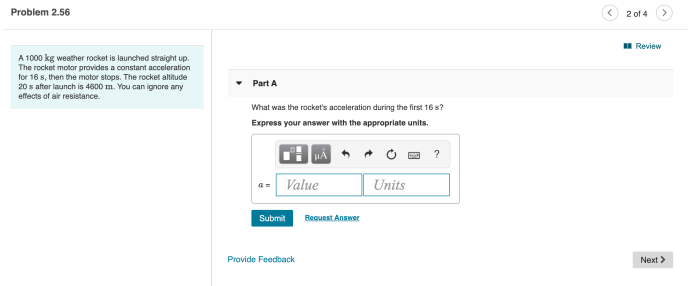A rocket is launched straight up with constant acceleration, embarking on a journey that showcases the principles of kinematics and dynamics. This analysis delves into the motion of the rocket, examining its velocity, displacement, and the forces acting upon it.
The exploration begins with an understanding of the relevant kinematic equations, followed by a detailed examination of the free-body diagram and the derivation of the equations of motion using Newton’s second law. The discussion encompasses the calculation of velocity and displacement at any given time, culminating in an investigation of the maximum height achieved by the rocket.
Introduction
A rocket is launched straight up with constant acceleration. The purpose of this analysis is to understand the motion of the rocket and the forces acting upon it.
Kinematic Equations
For motion with constant acceleration, the relevant kinematic equations are:
- Velocity: v = u + at
- Displacement: s = ut + 1/2at^2
- Acceleration: a = (v – u) / t
Free-Body Diagram

The free-body diagram of the rocket during its launch shows the following forces acting on it:
- Thrust: The upward force provided by the rocket’s engines
- Gravity: The downward force due to the Earth’s gravitational pull
- Air resistance: The opposing force due to the interaction with air molecules
Equations of Motion: A Rocket Is Launched Straight Up With Constant Acceleration

Using Newton’s second law, the equations of motion for the rocket are:
- Thrust – Gravity – Air resistance = ma
- where m is the mass of the rocket and a is its acceleration
Velocity and Displacement
To calculate the velocity and displacement of the rocket at any given time, we can use the kinematic equations:
- Velocity: v = u + at
- Displacement: s = ut + 1/2at^2
For example, if the rocket has an initial velocity of 0 m/s and accelerates at 9.8 m/s^2 for 10 seconds, its velocity at the end of 10 seconds will be 98 m/s and its displacement will be 490 meters.
Maximum Height
The maximum height reached by the rocket is the point at which its velocity becomes 0 m/s. Using the kinematic equation v^2 = u^2 + 2as, we can derive the formula for maximum height:
- Maximum height = (u^2) / (2g)
where u is the initial velocity and g is the acceleration due to gravity.
Air Resistance

Air resistance is a force that opposes the motion of the rocket. It is proportional to the square of the rocket’s velocity and can be incorporated into the equations of motion as follows:
- Thrust – Gravity – Air resistance = ma
- where Air resistance = -kv^2
where k is a constant that depends on the shape and size of the rocket.
FAQ Guide
What is the significance of constant acceleration in the rocket’s motion?
Constant acceleration implies a uniform rate of change in velocity, allowing for precise calculations of the rocket’s motion over time.
How does air resistance affect the rocket’s trajectory?
Air resistance opposes the rocket’s motion, causing a gradual decrease in its acceleration and ultimately limiting its maximum height.